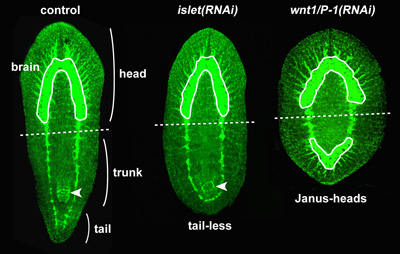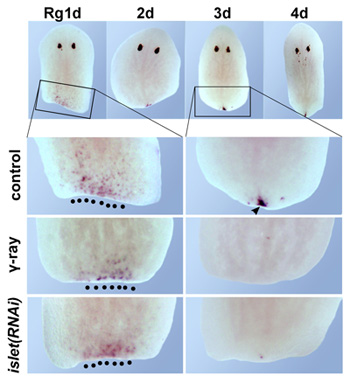| RIKEN Center for Developmental Biology (CDB) 2-2-3 Minatojima minamimachi, Chuo-ku, Kobe 650-0047, Japan |
February 9, 2012 –Planarians are a group of small flatworms with significant capacity for regeneration, which enables them to reform entire bodies from individual amputated fragments. To do so, however, each fragment needs to have a sense of where it should be in the body, so that missing head and tail regions form as needed and in the appropriate location with respect to the rest of the regenerating body. This positional information is thought to be conferred by gradients in the expression of various genes that activate, modulate or inhibit cell differentiation. The Wnt signaling pathway, for example, is known to be necessary for the specification of posterior regions. The molecular mechanisms that underlie this function, however, are poorly understood. A new study by Tetsutaro Hayashi and others in the Genome Resource and Analysis Unit (Fumio Matsuzaki, Unit Leader) now reveals an additional factor, encoded by a planarian LIM- homeobox gene known as Djislet, is required for the posterior differentiation of Wnt-expressing cells. Published in Development, this reports yields new insights into the coordination that occurs between stem and differentiated cells in an important model of animal regeneration.
The study began with the isolation of an apparent homolog of the vertebrate gene Islet from an EST (expressed sequence tag) library for the planarian species Dugesia japonica, which is indigenous to Japan. In vertebrates, the Islet family of LIM-homeobox transcription factors is known to be involved in the proliferation, maintenance and migration of stem and progenitor cells in a range of tissues. When Hayashi knocked down the function of this gene, dubbed Djislet, using RNA interference (RNAi), he found that its loss of function resulted in a tailless regeneration phenotype in fragments from any part of the body (head or trunk), suggesting that the gene might function in posterior differentiation and regeneration. This suggested in turn the possibility of a functional link to the Wnt signaling pathway, which had previously been shown to be required for posterior specification and regeneration in another flatworm species, Schmidtea mediterranea. Analysis of the expression of these genes, Djislet and Djwnt1/P-1, showed co-localization at the midline of the blastema, the locus of regeneration in planarians, at day 3 of regeneration. Moreover, in Djislet(RNAi) worms, the expression of Djwnt1/P-1 disappeared from the posterior blastema, suggesting that this gene functions downstream of the Islet function.
Interestingly, the loss of Islet function had a more limited effect than that of Wnt, in that Djwnt1/P-1(RNAi) worms show both tailless regeneration and occasional formation of two-headed regenerants (known as the Janus-heads phenotype), while Djislet(RNAi) animals regenerated without tails, but never with two heads. Examining gene expression in the process of Dugesia regeneration more closely, the lab found Wnt is expressed in two phases, at days 1 and 3, with the Islet homolog required only for the second. Importantly, this second phase is senstitive to γ-ray irradiation, suggesting that it involves stem cell-derived cells. Hayashi next checked the effect of Djislet(RNAi) on a panel of genes known to function in the posterior blastema, and was able to groups these into three classes: Class I, which includes genes expressed in γ-ray-insensitive cells not regulated by Djislet; Class II genes which are partly downregulated by loss of Djislet function; and Class III, which are mainly expressed in γ-ray-sensitive cells and strongly downregulated by Djislet(RNAi) at day 3 of regeneration. These findings collectively point to a role for Islet via Wnt signaling in the maintenance and activation of posterior genes in differentiating blastema cells for tail formation. |
|||||||
|
|||||||
 |
| Copyright (C) CENTER FOR DEVELOPMENTAL BIOLOGY All rights reserved. |

